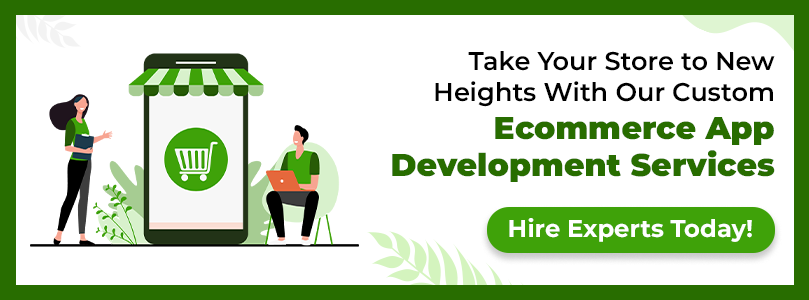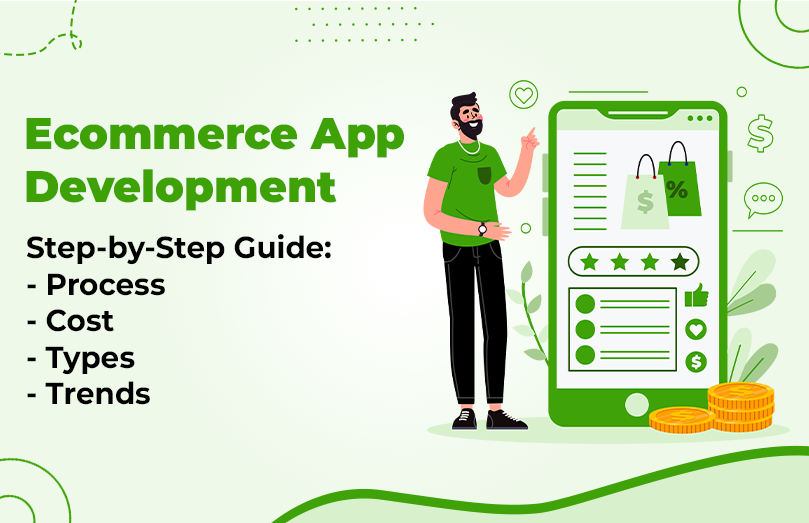In today’s world, purchasing anything can be done with just a few taps on the phone’s screen. Anybody can search through hundreds of things, compare prices and reviews, and have them delivered right to their home. A universe in which you may manage your online business and reach millions of people worldwide. Right? To join in, an ecommerce app is necessary. But:
- How do you create one?
- What are the steps involved?
- How much does it cost?
- What are the trends and best features?
Here, we have got you covered. Our ecommerce development services are thorough, covering all aspects from planning to execution and beyond through this article. We go above and beyond to ensure your app is successful.
The ecommerce sector is multiplying and proving to be very lucrative. According to Statista’s statistical data:
- Compared to mobile websites, mobile applications have a conversion rate that is three times greater.
- The UK is expected to see mobile e-commerce sales exceeding £80 billion in 2023.
- Additionally, over $1.1 trillion in sales are anticipated to be generated by the American e-commerce market in 2023.
Ecommerce App Development: 2023 Trends
In 2023, the increase in mobile shopping has led to the rise of voice and visual search and the adoption of new technologies such as AR/VR and AI. It’s essential to know these potential trends to stay informed:
- Voice Search: With the popularity of smart speakers and digital assistants like Alexa, Google Assistant, and Siri, voice search is becoming increasingly common and practical for online shopping. Natural language processing, conversational AI, and voice recognition are three techniques that e-commerce app developers must use to make their apps voice search-friendly.
- Visual Search: By enabling customers to look for items using images rather than terms, visual search improves the online buying experience. If you want to improve your e-commerce app, it’s essential to incorporate visual search features that utilize computer vision, picture recognition, and machine learning.
- AR/VR: For online consumers, augmented reality (AR) and virtual reality (VR) may provide engaging buying experiences. Developers of e-commerce apps may leverage AR and VR to add features like gamified shopping, virtual try-ons, 3D product displays, and virtual showrooms.
- AI: Several ecommerce app development processes, including customization, suggestion, customer support, fraud detection, and analytics, may be improved using artificial intelligence (AI). E-commerce software developers may use artificial intelligence (AI) to offer features like chatbots, product recommendations, dynamic pricing, sentiment analysis, and predictive analytics.
- Progressive Web Apps (PWAs): PWAs are online applications that may provide similar experiences to mobile apps. They can function offline, load rapidly, and deliver push alerts. They are quick, dependable, and satisfying. PWAs can help e-commerce app developers increase performance, audience, and conversion rates.
- Headless Commerce: Designing e-commerce applications with a front-end user interface but a back-end data and logic architecture is known as headless commerce. Developers of e-commerce apps may leverage headless commerce to make apps that adjust to various devices, platforms, and channels. The e-commerce app experience may be more flexible, scalable, and customizable thanks to it.
Types of Ecommerce App Development
1. The Aggregator’s App for Online Shopping
The concept of developing apps that combine many internet shops into a single one is new. But in reality, such an app works as an aggregator. This structure includes apps that provide a variety of pickup and delivery, storage, and transportation solutions. Your amenities are, therefore, extra. Afterwards, the provider will be able to give you access to the services provided by the aggregators.
2. Business-to-Business Apps
A B2B e-commerce app is an application that streamlines transaction activities between companies. This area of E-commerce app development focuses on completing orders placed by different businesses. B2B e-commerce services aid businesses in increasing their revenue. Because of this, businesses need the development of B2B e-commerce solutions.
3. Business-to-Consumer Apps
Web developers frequently make B2C E-commerce apps. It interacts with a business that does business straight with customers. When a customer has an issue, the management acts quite quickly. Another choice is to design an E-commerce application like Amazon or one that targets a specific market. Products related to a particular field are made available for purchase.
4. Customer-to-Customer Apps
In this scenario, two parties are involved in the trade – a customer and a supplier. One effective way to utilize this is to promote and sell niche items. These types of programs are often used on eBay and Amazon. However, it can be confusing to devise a plan at first.
5. Consumer-to-Business Apps
Businesses are still creating this kind of software regardless of its lack of availability. Throughout all levels, they offer possible results. Programmes for C2B e-commerce are excellent for helping individuals promote their offerings to enterprises. Including a consumer in your strategy for action could be an unusual idea. This tendency is seen in online employment platforms like Upwork, Freelancer, and others.
6. An Application for Online Bookings and Payments
With the help of e-commerce apps, purchasing tickets for plays or events while traveling has become more accessible. These mobile applications allow users to make reservations for various activities without requiring a massive infrastructure.
7. Apps for Bidding or Auctions
E-commerce applications for auctions and bidding have lately grown in popularity. Additionally, it can assist in lowering the cost of hosting auctions. Apps for bidding and auctions that operate autonomously are also available.

Best Features:
You can opt to incorporate the following essential features in your e-commerce application to maintain the interest of your users:
1. Buy-Now-Pay-Later
Using offerings like Afterpay, many consumers demand a choice to “buy now, pay later” (BNPL). Users can make a purchase and pay for it over time in several installments. Based on studies from Statista, consumers and businesses favor BNPL to make sizable installment purchases and payments. BNPL agreements are expected to grow to over $450 billion by 2026.
2. Retail Live Streaming
You may implement this remarkable aspect of Ecommerce app development as well. Live streams frequently post links to an item’s page that showcases the company’s goods. In the previous year, streaming live on online stores had a rate of conversion that was ten times higher than other components.
Procedure for Developing E-Commerce Apps
Now that you know the current trends and types of e-commerce apps, let’s proceed to the steps of developing one.
1. Define Your Objective
The initial and crucial phase in developing an e-commerce app is understanding your desired goal. The objective must be to get the application’s data to help the firm improve its products. Be specific when describing your aims, and give yourself time to plan to incorporate newer functions.
2. Target Market
The users will determine the accomplishment or failure of the supplemental E-commerce application. Because of this, it’s essential to accurately map the user population, encompassing their demographics, interests, beliefs, and program-related concerns.
Understanding the application’s target demographic is the first step in developing user experiences and narratives that entice users to return for more. Identifying the target audience and researching their interests is essential to ensure the app’s success.
3. Tech Innovations
Now that we have identified the target consumers and the required features, the next step in building an e-commerce app is determining the specific type of app needed. PWAs and Native applications are both immediate solutions for e-commerce applications.
App development enables both personalization and scalability. You may create your dream product by locating a technical partner that provides custom app development services. The final product made available to customers who browse the internet store will decide the most appropriate way to take action.
4. Planning Costs
It’s important to remember the available budget when adding capabilities and features to an E-commerce application, despite the effort put into discovering and seeking them out.
Entrepreneurs should be cautious about exceeding their budget when working with a cutting-edge software development company to ensure a positive return on investment (ROI).
5. Launching
Regardless of how precise the creation method for E-commerce apps is or how wise the individuals who design the project are, there will constantly be flaws. A comprehensive evaluation of the application’s load, regression, device, efficiency, adaptability, and usefulness must be part of standard operating practices for designing apps. To develop excellent documentation after testing, ensure the group has qualified testers.
How Much Does an Ecommerce App Development Company Cost to Develop an E-Commerce App?
It is the final section discussing the cost of building an eCommerce app. Estimating the exact cost of developing a mobile eCommerce app can be difficult. Business owners should carefully assess their budget, manage their spending, and determine if the potential reward is worth the risk.
Primarily the cost charged by an Ecommerce App Development Company is based on objectives and demands. For instance, the number of characteristics, mobile platforms, the intricacy of the UI/UX design, etc.
Secondly, the price varies according to a software development business’s location. Rates in Eastern Europe range from $35 to $60, which are the best. In contrast, app developer hourly fees in the US and Canada begin at $150, whereas in Western Europe, they might range from $50 to $100.
Conclusion
Ecommerce app development is critical for every firm that wants to flourish online. You can develop an e-commerce app that draws in and keeps users, increases sales and income, and offers you a competitive edge by following the guide and staying on top of the most recent trends and best practices.
Making an e-commerce app is not a do-it-yourself effort. A high-quality and effective software that satisfies your company objectives and user expectations must be created, and this takes professional ecommerce app development services, skills, expertise, and resources. You need to go no further than MMF Infotech if you’re seeking a business meeting the above criteria.
For e-commerce companies of all shapes and sizes, MMF Infotech is a top provider of mobile app design and development services. We offer a team of specialized app developers that can build user-friendly, safe, quick, and scalable bespoke e-commerce apps. Your demands for developing an e-commerce app can be fully satisfied.
Frequently Asked Questions
Q1. How Much Does it Cost to Develop an E-commerce App?
Q2. How to Develop an E-commerce App in Android?
1) Select your target market and specialization.
2) Pick a name and look for an app that fits.
3) Employ a seasoned e-commerce app development team or organization.
4) Describe the main characteristics and features of your app.
5) Utilize the most significant tech stack and tools when creating the app.
6) Check the app’s performance and quality.
7) Create the app, publish it on Google Play Store and promote it to your target users.
8) Regularly maintain and update the app.
These are the fundamental stages for developing an Android e-commerce app.


